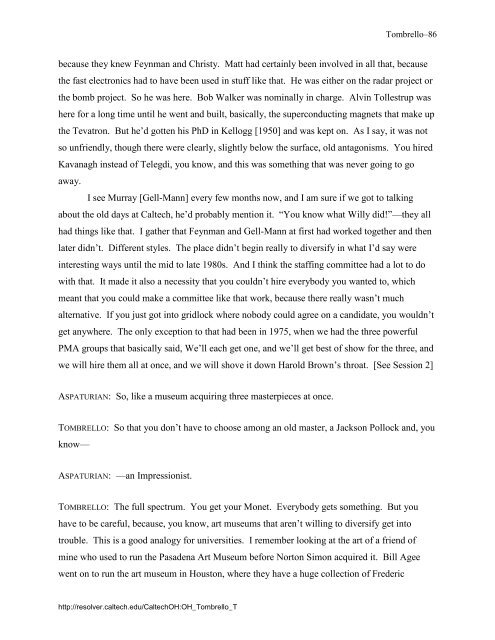Interview with Thomas A. Tombrello - Caltech Oral Histories
Interview with Thomas A. Tombrello - Caltech Oral Histories
Interview with Thomas A. Tombrello - Caltech Oral Histories
Create successful ePaper yourself
Turn your PDF publications into a flip-book with our unique Google optimized e-Paper software.
<strong>Tombrello</strong>–86<br />
because they knew Feynman and Christy. Matt had certainly been involved in all that, because<br />
the fast electronics had to have been used in stuff like that. He was either on the radar project or<br />
the bomb project. So he was here. Bob Walker was nominally in charge. Alvin Tollestrup was<br />
here for a long time until he went and built, basically, the superconducting magnets that make up<br />
the Tevatron. But he’d gotten his PhD in Kellogg [1950] and was kept on. As I say, it was not<br />
so unfriendly, though there were clearly, slightly below the surface, old antagonisms. You hired<br />
Kavanagh instead of Telegdi, you know, and this was something that was never going to go<br />
away.<br />
I see Murray [Gell-Mann] every few months now, and I am sure if we got to talking<br />
about the old days at <strong>Caltech</strong>, he’d probably mention it. “You know what Willy did!”—they all<br />
had things like that. I gather that Feynman and Gell-Mann at first had worked together and then<br />
later didn’t. Different styles. The place didn’t begin really to diversify in what I’d say were<br />
interesting ways until the mid to late 1980s. And I think the staffing committee had a lot to do<br />
<strong>with</strong> that. It made it also a necessity that you couldn’t hire everybody you wanted to, which<br />
meant that you could make a committee like that work, because there really wasn’t much<br />
alternative. If you just got into gridlock where nobody could agree on a candidate, you wouldn’t<br />
get anywhere. The only exception to that had been in 1975, when we had the three powerful<br />
PMA groups that basically said, We’ll each get one, and we’ll get best of show for the three, and<br />
we will hire them all at once, and we will shove it down Harold Brown’s throat. [See Session 2]<br />
ASPATURIAN: So, like a museum acquiring three masterpieces at once.<br />
TOMBRELLO: So that you don’t have to choose among an old master, a Jackson Pollock and, you<br />
know—<br />
ASPATURIAN: —an Impressionist.<br />
TOMBRELLO: The full spectrum. You get your Monet. Everybody gets something. But you<br />
have to be careful, because, you know, art museums that aren’t willing to diversify get into<br />
trouble. This is a good analogy for universities. I remember looking at the art of a friend of<br />
mine who used to run the Pasadena Art Museum before Norton Simon acquired it. Bill Agee<br />
went on to run the art museum in Houston, where they have a huge collection of Frederic<br />
http://resolver.caltech.edu/<strong>Caltech</strong>OH:OH_<strong>Tombrello</strong>_T

















